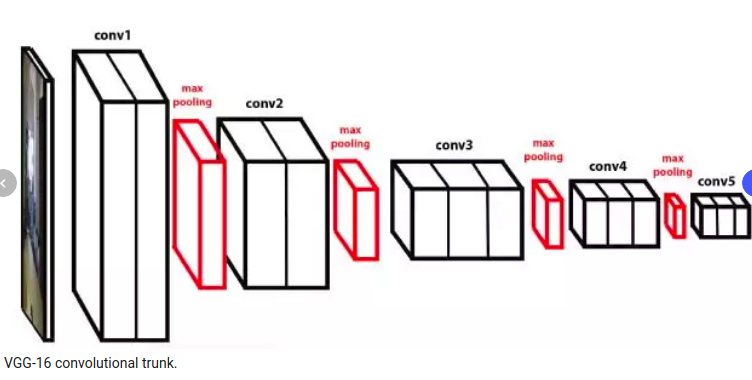In this project, you'll label the pixels of a road in images using a Fully Convolutional Network (FCN).
We used pre-trained VGG16 network as below diagram.
We loaded the pre-trained VGG16 and get the layer 3, layer 4, and layer 7 for FCN.
graph = tf.get_default_graph()
tf.saved_model.loader.load(sess,[vgg_tag],vgg_path)
i1 = graph.get_tensor_by_name(vgg_input_tensor_name)
k1 = graph.get_tensor_by_name(vgg_keep_prob_tensor_name)
l3 = graph.get_tensor_by_name(vgg_layer3_out_tensor_name)
l4 = graph.get_tensor_by_name(vgg_layer4_out_tensor_name)
l7 = graph.get_tensor_by_name(vgg_layer7_out_tensor_name)
For FCN, We convt the VGG layer 7 and deconv it with a 2x2 kernel into Deconv1.
conv_1x1_vgg7 = tf.layers.conv2d(vgg_layer7_out, num_classes, 1 , padding = 'same',
kernel_regularizer=tf.contrib.layers.l2_regularizer(1e-3))
deconv_2x2_1 = tf.layers.conv2d_transpose(conv_1x1_vgg7, num_classes, 4, 2 , padding = 'same',
kernel_regularizer=tf.contrib.layers.l2_regularizer(1e-3))
Then we convt the VGG layer 4, and add up this conv layer with Deconv1 into a skip_layer_1 .
conv_1x1_vgg4 = tf.layers.conv2d(vgg_layer4_out, num_classes, 1 , padding = 'same',
kernel_regularizer=tf.contrib.layers.l2_regularizer(1e-3))
skip_layer_1 = tf.add(deconv_2x2_1,conv_1x1_vgg4)
We deconv the skip_layer_1 with a 2x2 kernel as Deconv2.
deconv_2x2_2 = tf.layers.conv2d_transpose(skip_layer_1 , num_classes, 4, 2 , padding = 'same',
kernel_regularizer=tf.contrib.layers.l2_regularizer(1e-3))
we convt the VGG layer 3, and add up this conv layer with Deconv2 into a skip_layer_2 .
conv_1x1_vgg3 = tf.layers.conv2d(vgg_layer3_out, num_classes, 1 , padding = 'same',
kernel_regularizer=tf.contrib.layers.l2_regularizer(1e-3))
skip_layer_2 = tf.add(deconv_2x2_2,conv_1x1_vgg3)
Finally, We deconv the skip_layer_2 with a 8x8 kernel as Deconv3.
deconv_8x8_3 = tf.layers.conv2d_transpose(skip_layer_2, num_classes, 16, 8 , padding = 'same',
kernel_regularizer=tf.contrib.layers.l2_regularizer(1e-3))
We "adaptive moment estimation" to optimize the network.
I used below parameters for the final result. LEARNING_RATE = 1e-4 EPOCHS = 100 BATCH_SIZE = 8 KEEP_PROB = 0.8
Here is the diagram to track loss over epoches, and the loss goes down to >0.1 after 50 epoches.

If I remove the skip layer and only use vgg layer 7 as the input of deconv layers. the results became like below diagram.
If I only use 20 epoches instead of 100 epoches, you will see some wrong classified pixeles all over the picture.
main.py will check to make sure you are using GPU - if you don't have a GPU on your system, you can use AWS or another cloud computing platform.
Make sure you have the following is installed:
Download the Kitti Road dataset from here. Extract the dataset in the data folder. This will create the folder data_road with all the training a test images.
Run the following command to run the project:
python main.py










